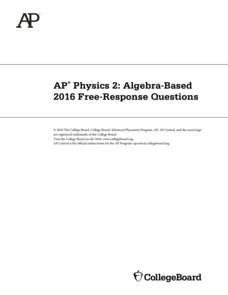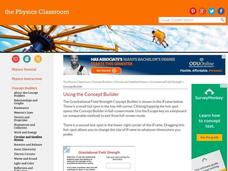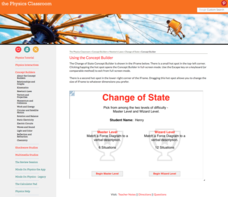Southwest Educational Development Laboratory
Simple Machines
Simple doesn't mean useless. Individuals learn how simple machines benefit the user by changing the amount of effort. A seven-lesson unit begins with an overview of simple machines and then incorporates activities that allow the user to...
Purdue University
Simple Machines
What's the best way to use a simple machine to solve a real-world problem? Scholars construct their own simple and complex machines to explore the concepts of work and force. They discuss examples of simple machines they have found in...
Purdue University
Slow Boat Design
Don't be a drag. Learners work in groups to design boats that move slowly. The provided reason for the activity is that a fish caught on a fishing reel is pulling the boat, causing it to move too fast. The STEM activity teaches the class...
Purdue University
Designing Safer Roadways
Be careful on curvy roads. An interesting STEM activity challenges scholars to design a safe road system. The goal is to help ensure that cars coming down a hill will be able to make a right turn without sliding off the road. Pupils test...
Purdue University
Lifeguard Chair
Save the class from a lack of engineering experience. An engaging STEM activity has learners work in groups to design a lifeguard chair out of masking tape and index cards. They build and test prototypes, all while learning about the...
College Board
2016 AP® Physics 2: Algebra-Based Free-Response Questions
While AP Physics 1 counts as an introductory college Physics course, AP Physics 2 counts as a second-year college Physics course. Help scholars prepare for this more advanced college-level test with questions from previous assessments...
College Board
2018 AP® Physics 1: Algebra-Based Free-Response Questions
Whether determining orbitals of space craft or designing experiments with conductive dough, many young scientists discover physics is phun and attempt the AP exam to get college credit. Use the free response questions from the 2018...
Magic of Physics
Planetary Rescue Squad
Ready, aim ... learn! Increase scholars' understanding of force, mass, distance, and angle using an engaging interactive. Pupils participate in a series of rescue missions where they launch supplies at a target with an adjustable cannon....
Physics Classroom
Fnet = m•a
Most pupils learn quickly how to apply Newton's Second Law equation to calculate net force. However, many struggle to determine net force before calculating the value of an unknown force from a force diagram. As part of a larger series...
Physics Classroom
Gravitational Field Strength
Budding scientists fall hard for a gravitational field strength activity! Physics pupils compare the masses and distances relative to the center of planets using an interactive from a Circular and Satellite Motion series. Individuals...
Physics Classroom
Torque-ing About Rotation
Let's talk torque! Science scholars evaluate experimental setups during an interactive from the Rotation and Balance series. Individuals calculate the torque of differently arranged weights to determine the effect they have on a balanced...
Physics Classroom
Getting a Handle on Torque
Do your young physicists get a little unbalanced when it comes to talking about torque? Scholars examine the effects of weight and distance on a balanced system with a simple interactive from the Rotation and Balance series. The resource...
Physics Classroom
Case Studies: Impulse and Force
Why are gym walls padded and cars required to have air bags? Scholars observe two similar situations, such as those listed above, with only one variable altered. They identify the different variable and determine how the variation...
Physics Classroom
Newton's Second Law
Physics formulas provide more interest than simple math equations thanks to an informative installment from the series on Newton's laws of motion. The formulas guide pupils' thinking about how varying a quantity affects the rest of the...
Physics Classroom
Match That Free-Body Diagram
Pupils read a description of a physical situation and select the free-body diagram that best matches. As part of a series on applying Newton's Laws of Motion, scholars reinforce their skills applying forces and considering their relative...
Physics Classroom
Recognizing Forces
A common complaint among physics scholars studying Newton's laws of motion concerns drawing free-body diagrams. To practice the required pre-requisite skills for free-body diagrams, individuals identify which forces act in specific...
Physics Classroom
Change of State
Free-body diagrams display all forces acting on an object, helping scientists represent Newton's Laws of Motion. Scholars read a short description of motion and view the free-body diagram to begin the installment of a larger series on...
Physics Classroom
Force and Motion
Scholars focus on associating balanced forces with at rest or constant velocity motion and unbalanced forces with acceleration or deceleration. Practice problems with immediate feedback allow for quick success in an installment of the...
Physics Classroom
Balanced vs. Unbalanced Forces
Scientists use many different kinematic representations of motion. Review each of them with the help of an engaging interactive that is part of a larger series on Newton's laws of motion. The resource provides three levels of challenge...
Community Resources for Science
Spring Mechanics
Scholars practice calculating spring constants before performing hands-on experiments. They compare data for parallel and series springs. Finally, they learn how spring mechanics find applications in biotechnology, such as prosthetic limbs.
Physics Classroom
Electric Field Intensity
Learning about electrostatics can be pretty intense! Physics fanatics explore the factors that affect electric field intensity using an interactive from the Static Electricity series. Learners work to complete data tables that relate...
Physics Classroom
Coulombs Law
How are charge, distance, and force related in electrostatics? Science scholars ponder the outcomes of changing variables using an interactive resource from the Static Electricity series. Individuals practice using Coulomb's Law as they...
Kenan Fellows
The Newton Challenge
Make Newton proud. Scholars apply their understanding of forces and energy to an engineering design challenge. They learn about simple machines, create a presentation on Newton's laws, and develop a balloon-powered car.
Kenan Fellows
Analyzing Speed from Different Modalities
Show us your moves. Using sensor equipment, scholars track the motion of different movements, such as jogging, skipping, or jump roping. They analyze velocity and acceleration and create graphs representing each movement.

























